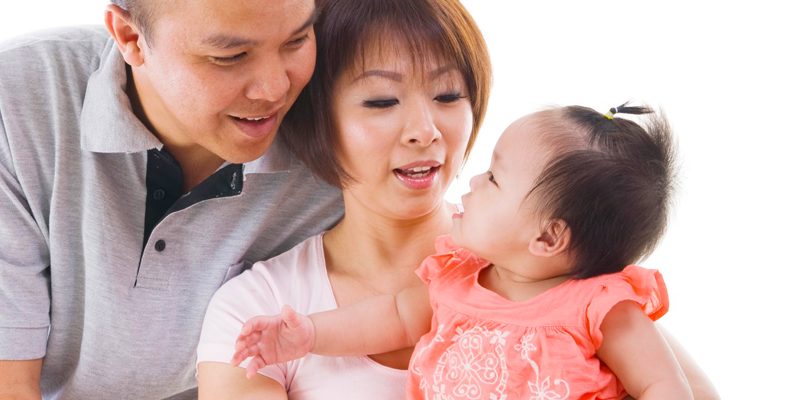
Baby’s Communication Skills: Bye-Bye, Baby Talk. Hello, Real Speech!
Your baby’s communication skills are growing, and she really wants to put them to work! In particular, you will notice a great improvement in her Expressive Language skills as her babbling begins to sound more and more like actual speech, with inflection, speech-specific tones, and pauses similar to sentence breaks. While you may still hear your baby say “uh-oh” when something is dropped, at this point it could also be an invitation for you to play a “pick it up” game!1
(SPECIAL OFFER: Sign up for Playful Bee’s Bee Well developmental learning program to give your baby the best start in life. The first 10,000 children enroll for FREE! Sign up today.)
By now, your baby can tell how you feel by hearing the tone of your voice. She may also use emotional tones in her own communication with you, making a frustrated grunt or a squeal of joy. She will even start using simple words like “Mama,” “Dada,” “mine,” and “no” more frequently and appropriately.1,2
Now that she is making an effort to express herself through language, it is important for you to change the way you speak to her. Although you started off using high-pitched “parentese,” or baby talk, to talk to your baby when she was a baby, now that she’s older it’s time to use clear, adult language. One way to do this is to use pronouns instead of third person references, so she can become familiar with this common part of speech. For example, tell your baby, “I am going to the store” instead of “Mama is going to the store” or “Would you like to go to the park?” instead of “Does Johnny want to go to the park?”
Be sure to exaggerate the inflection of your voice when you are asking questions or making statements to show your baby that there is a difference in sound and, therefore, meaning between the two types of sentences. Consider using gestures, pictures, or any other simple visual aids to make your language more clear and understandable to her.
Encourage the curious and inquisitive explorer in your baby by answering every inquiry with a thoughtful and expansive response. If she points to a dog, give her some information about it, such as “That is a big, furry, brown dog! His name is Taco!” You can also start offering choices at this age to help let you know her preferences.3,4 For example, say, “Do you want to use red cup or the blue one?” as you hold up each cup. All of these skills will further develop your 12-18 month child’s exploding Expressive Language abilities.
Play Tips:
Do you want to know how you can support your baby’s development of these Expressive Language skills at this age? It’s easy! Read on for some simple tips to incorporate into your daily play time together.
- Have conversations using clear adult language. It is best to use “baby talk” less now that your baby is learning new words every day. Be sure to use proper grammar. For example, use pronouns instead of using third person speech in sentences such as “Are you hungry? Would you like a banana?”
- Respond to every question your baby asks by giving her some new information. If your baby points to the stove, tell her, “The stove is hot! Don’t touch!” You can help improve her understanding of hot and cold by using water to let her feel the difference. Let her touch warm water as you repeat the word “hot,” and say the word “cold” as she puts her hand in cool water.
- Give your baby specific choices, and ask for a response. The more you ask your baby to communicate, the more confident she will be in expressing herself!
(SPECIAL OFFER: Sign up for Playful Bee’s Bee Well developmental learning program to give your baby the best start in life. The first 10,000 children enroll for FREE! Sign up today.)
Developmental Milestones:
Has your baby achieved the following Expressive Language developmental milestones yet? If yes, check off all the skill(s) she has already mastered to date using Playful Bee’s developmental milestones tracker. It’s absolutely FREE and easy to use, just click HERE!
- Points to communicate interesting objects.
Sources:
1Illinois State Board of Education. For Children Birth to Age Three: Illinois Early Learning Guidelines.
2Ohio Child Care Resource and Referral Association (2006). Ohio’s Infant Toddler Guidelines.
3Fox, Marilyn S. (2007). Parenting Your Child Effectively: Give Choices. NebGuide, University of Nebraska-Lincoln Extension. Retrieved December 17, 2013, from http://extensionpublications.unl.edu/assets/pdf/g1728.pdf.
4Grossman, Sue. Offering Children Choices: Encouraging Autonomy and Learning while Minimizing Conflicts. Early Childhood News. Retrieved December 17, 2013, from http://www.earlychildhoodnews.com/earlychildhood/article_view.aspx?ArticleID=607.
Playful Bee
Latest posts by Playful Bee (see all)
- Have a Super Fortune Cookie Friday! - February 9, 2018
- All Kinds of Shapes: Your Child Is Learning Simple Shapes, and Drawing Them Too! - November 13, 2017
- Fishing for Sneakers: Create your own Hand-Eye Coordination Fun - November 11, 2017

+ There are no comments
Add yours